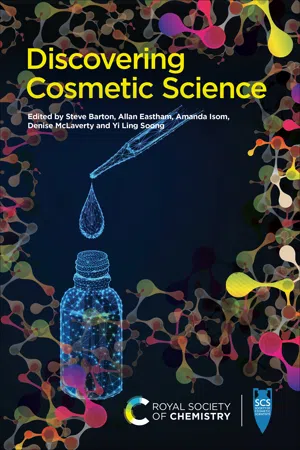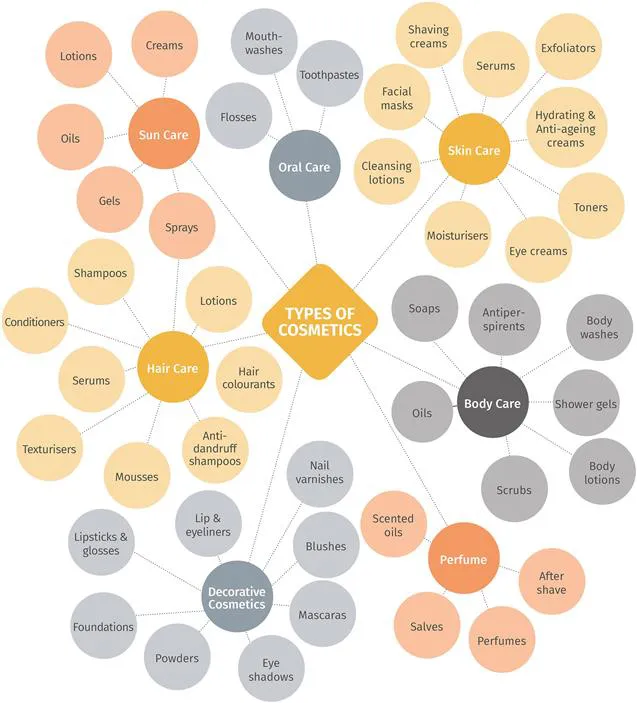![]()
CHAPTER 1
Introduction
STEVE BARTON,*a ALLAN EASTHAM,b AMANDA ISOM,c DENISE MCLAVERTY,d YI LING SOONGe AND RACHAEL POLOWYJf
a Skin Thinking LtdNottinghamUK
b CosmaridaSheffieldUK
c Bloom Regulatory LtdLondonUK
d Venture Logic LtdUK
e The Body Shop International LtdUK
f IMCD UK LtdUK
Welcome to this ‘novice's guide’ – at last, a book that explains the real science behind the cosmetics you use. We are assuming nothing about you, the reader, your background or expertise. The fact that you are reading this introduction suggests that you are interested in finding out more! Which is why we had the idea of putting these chapters together. We guessed that there may be quite a few of you wanting to find out what some of those strange-sounding chemicals listed on your shower gel are doing in a product, and why. Or maybe you want to settle an argument about what cosmetics actually do. We'd like to think that there are lots of teachers or journalists needing to know more about a subject you'd like to communicate to others. Students or others wanting to find out if this is the career for you – we'd love to encourage you by sharing the authors’ many years of scientific knowledge. Or you may simply like the front cover! Whatever the case, we have plenty of science for you to discover. This introductory chapter aims to set the scene and start you thinking about the science and concepts that you'll come across in the subsequent chapters of this book. Let's start by asking you a question.
1.1 HOW MANY COSMETIC PRODUCTS DO YOU USE IN THE DAY?†
Do you shower first thing? Or clean your teeth? Or rub oil into your beard? Or put dry shampoo on your hair because you are in a hurry? All of these activities will involve some kind of cosmetic product. How do all these products work? Why might they be needed? Are they all ‘hype’? To answer these and other questions, we'll try to use a gentle approach, giving you a ‘guided journey’ through the different product types.
Figure 1.1 Diagram showing the range of types of cosmetic products organised and colour coded in their ‘families’. This useful reference should help guide you through the coming chapters. Reproduced with permission from Cosmetics Europe (https://cosmeticseurope.eu/cosmetic-products).
You'll see from the Contents list that we have approached this journey by stopping off at each of the ‘core technologies’ and the product areas they support. Then we've added some important destinations – showing you the science behind safety – before ending up by dispelling some of the myths that find their way into the public domain. In reality, a cosmetic scientist developing a product will need a broad understanding of all of these topics in their daily work.
Reading this book, you'll discover that, while cosmetic products often sit on the surface, they are not as superficial as often thought. We think that you will learn that there's some amazing science behind them – we will go into this in some detail in places, but you won't need a PhD to understand the science. We shall also point out some interesting facts on our way, uncovering some of the truths behind the myths. Look out for Boxes in the chapters where authors either explain things in more detail or go off on an interesting side road during your journey of discovery. We've also pointed you in the direction of further reading if you want to know more. We know you'll have lots of questions to ask and we will try to pre-empt these if we can.
To set the scene, we suspect your next question may be …
1.2 WHAT IS A ‘COSMETIC’?
The word ‘cosmetic’ shares its origin with ‘cosmos’, from the Greek ‘kosmos’, their word describing ‘order’ or ‘ornament’. This second meaning has led to ‘cosmetic’ being used to describe the outer appearance. This focus on surface or superficial matters has also led to the interpretation that cosmetic products are somehow trivial or lacking depth; we think you'll change your mind after reading this book. This ‘ornamentation’ definition also leads many to think that the term cosmetic product just applies to ‘makeup’. Makeup, sometimes called colour cosmetics or decorative cosmetics, is indeed one class of cosmetic product. However, there are many different classes used by millions of consumers every day. Why? Well, mostly to help keep themselves clean and hygienic, looking and feeling fresh and maintaining a healthy appearance. Generally, then, the definitions of cosmetics and personal care products around the world are similar. They focus on the ‘appearance’ of the outer body surfaces – the skin, hair and teeth – keeping them clean, perfuming or correcting body odours. Definitions also include changing the appearance of these surfaces, protecting them and keeping them in good condition, or, as in the other meaning of ‘kosmos’, in good ‘order’. It is these aims that all cosmetic science is designed to achieve.
Figure 1.1 gives some examples of the myriad of products covered by the term ‘cosmetic’.
Each area of the world will have its own legal definition of ‘cosmetic product’. Although there are many commonalities, some products classified as cosmetic in the UK and European Union (EU) are classed as different product types in other jurisdictions. For example, sunscreens, which are cosmetic products in the UK and EU, are classed as over-the-counter (OTC) medicines in the USA; hair dyes are cosmetic products in Europe and the USA but are classed as ‘quasi-drugs’ in Japan.
The main purpose of the laws governing the manufacture and sale of cosmetic products is consumer safety. Companies making and selling cosmetic products, and the regulatory bodies charged with implementing and policing the legislation, have a duty of care to ensure that human health is not compromised. You will find out some of the ways in which this works in practice, and the science behind it, in Chapter 10.
However, wherever a cosmetic product is placed on the market in the world, the core science and technologies are the same.
1.3 WHAT GOES INTO A COSMETIC PRODUCT?
Hopefully, by now you are eager to know more about this; once you get into the later chapters, you'll find out more. However, there may be one feature of your cosmetic products you're already aware of – the list of ingredients, often seen on the back of a pack. This legal requirement is designed to help people identify, and so avoid, products with ingredients that they know they are sensitive or allergic to. Although there are minor differences around the world, the European markets implemented the International Nomenclature of Cosmetic Ingredients naming system, known as INCI, and this has also been adopted by many countries worldwide. INCI names are based on chemical identity and structure and you'll discover some of these as you read on (for more on naming conventions see Section 1.4). However, we will try not to overload you with too many of these. We can't possibly cover them all, but we've tried to give you some insights into what is used and why (see Box 1.1). So here we can start by talking about the different roles that ingredients play in the product.
BOX 1.1 INCI LISTINGS
Table 1.1 shows two simple products and their INCI listings. In this case we also show the function of the ingredients in the products. For several reasons it is not possible to show all this information on a product INCI listing – that's not the purpose of the listing, some ingredients may have more than one function and space on the label is often limited. Even these very simple products have a long list of ingredients that must be declared and, as you will see, many different functions. Many companies, however, do provide more information on their websites, describing some of the ingredients that they use and why.
We will not go into every item here – keep on reading this book and you'll find out more about the functions and chemistry of surfactants, emulsifiers, emollients, colourants, preservatives and so much more. However, there are a few important things to pick out, as follows.
Aqua – Water! Why is it given a Latin name? – well, it is short and commonly understood around European countries where INCI names were intended to be used. You will also notice here, and in the majority of products, that aqua is the main ingredient as a solvent.
More Latin names – Salix nigra bark extract; Butyrospermum parkii butter; Olea europaea fruit oil. These are all plant materials commonly used for many years in cosmetic products – willow bark, shea butter and olive oil, respectively. However, using the botanical (Latin) name for the plant and the part of the plant is important. Common names of plants differ around the world; different parts of a plant contain different chemical compounds, some of which could be toxic. This scientific naming convention ensures a universal understanding of the part of the plant being used and its safety profile.
Alcohol – You'll see this term twice in the body lotion. ‘Alcohol’ is class of chemicals that have a carbon backbone and an OH (hydroxyl) group. ‘Alcohol’ in an INCI list means ethyl alcohol (ethanol), with its solvent and cooling properties – chemically the same as the alcohol in wine, beer, etc. Cetyl alcohol is a ‘bigger’ alcohol in molecular size – it has more carbons in its chain – and that makes it a waxy solid rather than a liquid. Just to make life really interesting there are other names in these INCI lists that end in ‘-ol’, e.g. phenoxyethanol; hexylene glycol; caprylyl glycol; panthenol. The ‘-ol’ indicates that these chemicals have a hydroxyl group in their structure. For those of you who know Sweden, you may recognise the term ‘öl’, being Swedish for beer!
More than one function – You will see here that some ingredients are given more than one function in the product. One of the many wonders of chemistry is that one molecular structure can confer several properties – you only have to think of the many uses of water to understand this. Formulators choosing cetyl alcohol know that its waxy nature leaves a softening, emollient effect on the skin and that it also forms part of the emulsion structure. This can help stabilize the product – see Chapter 5 for more on this.
Another thing that you'll notice is that, unlike a cooking recipe, there is no indication of the proportions used. This is for good reason. First, it is not a recipe; INCI lis...

